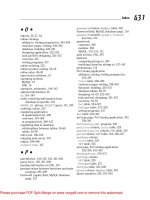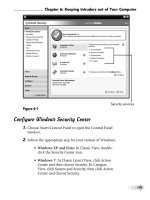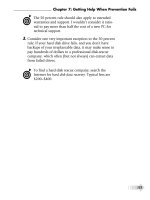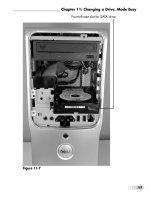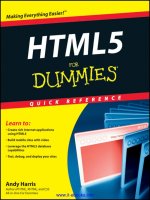accounting for dummies
Bạn đang xem bản rút gọn của tài liệu. Xem và tải ngay bản đầy đủ của tài liệu tại đây (4.36 MB, 410 trang )
By John A.Tracy, CPA
Accounting
FOR
DUMmIES
‰
4TH EDITION
01_246009 ffirs.qxp 4/16/08 11:49 PM Page iii
01_246009 ffirs.qxp 4/16/08 11:49 PM Page ii
Accounting
FOR
DUMmIES
‰
4TH EDITION
01_246009 ffirs.qxp 4/16/08 11:49 PM Page i
01_246009 ffirs.qxp 4/16/08 11:49 PM Page ii
By John A.Tracy, CPA
Accounting
FOR
DUMmIES
‰
4TH EDITION
01_246009 ffirs.qxp 4/16/08 11:49 PM Page iii
Accounting For Dummies
®
, 4th Edition
Published by
Wiley Publishing, Inc.
111 River St.
Hoboken, NJ 07030-5774
www.wiley.com
Copyright © 2008 by Wiley Publishing, Inc., Indianapolis, Indiana
Published by Wiley Publishing, Inc., Indianapolis, Indiana
Published simultaneously in Canada
No part of this publication may be reproduced, stored in a retrieval system, or transmitted in any form
or by any means, electronic, mechanical, photocopying, recording, scanning, or otherwise, except as
permitted under Sections 107 or 108 of the 1976 United States Copyright Act, without either the prior
written permission of the Publisher, or authorization through payment of the appropriate per-copy fee to
the Copyright Clearance Center, 222 Rosewood Drive, Danvers, MA 01923, 978-750-8400, fax 978-646-8600.
Requests to the Publisher for permission should be addressed to the Legal Department, Wiley Publishing,
Inc., 10475 Crosspoint Blvd., Indianapolis, IN 46256, 317-572-3447, fax 317-572-4355, or online at http://
www.wiley.com/go/permissions.
Trademarks: Wiley, the Wiley Publishing logo, For Dummies, the Dummies Man logo, A Reference for the
Rest of Us!, The Dummies Way, Dummies Daily, The Fun and Easy Way, Dummies.com and related trade
dress are trademarks or registered trademarks of John Wiley & Sons, Inc. and/or its affiliates in the United
States and other countries, and may not be used without written permission. All other trademarks are the
property of their respective owners. Wiley Publishing, Inc., is not associated with any product or vendor
mentioned in this book.
LIMIT OF LIABILITY/DISCLAIMER OF W
ARRANTY: THE PUBLISHER AND THE AUTHOR MAKE NO REP-
RESENTATIONS OR WARRANTIES WITH RESPECT TO THE ACCURACY OR COMPLETENESS OF THE
CONTENTS OF THIS WORK AND SPECIFICALLY DISCLAIM ALL WARRANTIES, INCLUDING WITHOUT
LIMITATION WARRANTIES OF FITNESS FOR A PARTICULAR PURPOSE. NO WARRANTY MAY BE CRE-
ATED OR EXTENDED BY SALES OR PROMOTIONAL MATERIALS. THE ADVICE AND STRATEGIES CON-
TAINED HEREIN MAY NOT BE SUITABLE FOR EVERY SITUATION. THIS WORK IS SOLD WITH THE
UNDERSTANDING THAT THE PUBLISHER IS NOT ENGAGED IN RENDERING LEGAL, ACCOUNTING, OR
OTHER PROFESSIONAL SERVICES. IF PROFESSIONAL ASSISTANCE IS REQUIRED, THE SERVICES OF A
COMPETENT PROFESSIONAL PERSON SHOULD BE SOUGHT. NEITHER THE PUBLISHER NOR THE
AUTHOR SHALL BE LIABLE FOR DAMAGES ARISING HEREFROM. THE FACT THAT AN ORGANIZATION
OR WEBSITE IS REFERRED TO IN THIS WORK AS A CITATION AND/OR A POTENTIAL SOURCE OF FUR-
THER INFORMATION DOES NOT MEAN THAT THE AUTHOR OR THE PUBLISHER ENDORSES THE INFOR-
MATION THE ORGANIZATION OR WEBSITE MAY PROVIDE OR RECOMMENDATIONS IT MAY MAKE.
FURTHER, READERS SHOULD BE AWARE THAT INTERNET WEBSITES LISTED IN THIS WORK MAY HAVE
CHANGED OR DISAPPEARED BETWEEN WHEN THIS WORK WAS WRITTEN AND WHEN IT IS READ.
For general information on our other products and services, please contact our Customer Care
Department within the U.S. at 800-762-2974, outside the U.S. at 317-572-3993, or fax 317-572-4002.
For technical support, please visit www.wiley.com/techsupport.
Wiley also publishes its books in a variety of electronic formats. Some content that appears in print may
not be available in electronic books.
Library of Congress Control Number: 2008926448
ISBN: 978-0-470-24600-9
Manufactured in the United States of America
10 9 8 7 6 5 4 3 2 1
01_246009 ffirs.qxp 4/16/08 11:49 PM Page iv
About the Author
John A. Tracy (Boulder, Colorado) is Professor of Accounting, Emeritus, at
the University of Colorado in Boulder. Before his 35-year tenure at Boulder,
he was on the business faculty for four years at the University of California
in Berkeley. Early in his career he was a staff accountant with Ernst & Young.
John is the author of several books on accounting and finance, including The
Fast Forward MBA in Finance, How To Read a Financial Report, and Small
Business Financial Management Kit For Dummies with his son Tage Tracy.
John received his BSC degree from Creighton University. He earned his MBA
and PhD degrees at the University of Wisconsin in Madison. He is a CPA (inac-
tive) in Colorado.
01_246009 ffirs.qxp 4/16/08 11:49 PM Page v
01_246009 ffirs.qxp 4/16/08 11:49 PM Page vi
Dedication
For our grandchildren — Alexander, Ryan, Mitchel, Paige, Katrina, Claire,
Eric, MacKenzie, Madison, Tanner, Karsen, and Brody.
Author’s Acknowledgments
I’m deeply grateful to everyone at Wiley Publishing who helped produce this
book. Their professionalism, courtesy, and good humor were much appreci-
ated. I supplied some words, and the editors and production staff at Wiley
molded them into the finished product.
Out of the blue, I got a call in 1996 from Kathy Welton, then Vice President
and Publisher for the Consumer Publishing Group of the For Dummies books.
Kathy asked if I’d be interested in doing this book. It didn’t take me very long
to say yes. Thank you again, Kathy!
I can’t say enough nice things about Pam Mourouzis, who was project editor
on the first edition of the book. The book is immensely better for her insights
and advice. The two copyeditors on the book — Diane Giangrossi and Joe
Jansen — did a wonderful job. Mary Metcalfe provided valuable suggestions
on the manuscript. Thanks to Holly McGuire and Jill Alexander who encour-
aged me to revise the book. The second edition benefited from the editing by
Norm Crampton and Ben Nussbaum.
I thank Stacy Kennedy, acquisitions editor, for asking me to do this and the
previous revision. Joan Friedman was the project editor on this and the
previous edition. Evidently, Wiley assigned me the best editor they have.
Joan kept a steady hand on the tiller as we sailed through the choppy waters
of the revisions. Joan was a delight to work with, and it goes without saying
that she made the book much better. Thank you most sincerely Joan, and I
hope to work with you again on the next revision.
One reason I like to write books goes back to an accounting class in my
undergraduate days at Creighton University in Omaha. I took a course taught
by the Dean of the Business School, Dr. Floyd Walsh. I turned in a term paper,
and he said that it was very well written. I have never forgotten that compli-
ment. I think my old Prof would be proud of this book and might even give me
an “A” on the assignment.
01_246009 ffirs.qxp 4/16/08 11:49 PM Page vii
Publisher’s Acknowledgments
We’re proud of this book; please send us your comments through our Dummies online registration
form located at www.dummies.com/register/.
Some of the people who helped bring this book to market include the following:
Acquisitions, Editorial, and
Media Development
Project Editor: Joan Friedman
(Previous Editions: Norm Crampton,
Pam Mourouzis)
Acquisitions Editor: Stacy Kennedy
Technical Editor: Michael Newman, PhD
Editorial Manager: Jennifer Ehrlich
Editorial Supervisor: Carmen Krikorian
Editorial Assistants: Erin Calligan Mooney,
Joe Niesen, David Lutton
Cartoons: Rich Tennant
(www.the5thwave.com)
Composition Services
Project Coordinator: Katie Key
Layout and Graphics: Brooke Graczyk,
Melissa K. Jester, Laura Pence,
Christine Williams
Proofreaders: Laura Albert, John Greenough,
Nancy L. Reinhardt
Indexer: Infodex Indexing Services, Inc.
Publishing and Editorial for Consumer Dummies
Diane Graves Steele, Vice President and Publisher, Consumer Dummies
Joyce Pepple, Acquisitions Director, Consumer Dummies
Kristin A. Cocks, Product Development Director, Consumer Dummies
Michael Spring, Vice President and Publisher, Travel
Kelly Regan, Editorial Director, Travel
Publishing for Technology Dummies
Andy Cummings, Vice President and Publisher, Dummies Technology/General User
Composition Services
Gerry Fahey, Vice President of Production Services
Debbie Stailey, Director of Composition Services
01_246009 ffirs.qxp 4/16/08 11:49 PM Page viii
Contents at a Glance
Introduction 1
Part I: Opening the Books on Accounting 11
Chapter 1: Accounting: The Language of Business, Investing, Finance, and Taxes 13
Chapter 2: Financial Statements and Accounting Standards 31
Chapter 3: Bookkeeping and Accounting Systems 53
Part II: Figuring Out Financial Statements 75
Chapter 4: Reporting Revenue, Expenses, and the Bottom Line 77
Chapter 5: Reporting Assets, Liabilities, and Owners’ Equity 97
Chapter 6: Reporting Cash Flows 119
Chapter 7: Choosing Accounting Methods: Different Strokes for Different Folks 137
Part III: Accounting in Managing a Business 159
Chapter 8: Deciding the Legal Structure for a Business 161
Chapter 9: Analyzing and Managing Profit 183
Chapter 10: Financial Planning, Budgeting, and Control 205
Chapter 11: Cost Concepts and Conundrums 223
Part IV: Preparing and Using Financial Reports 245
Chapter 12: Getting a Financial Report Ready for Release 247
Chapter 13: How Lenders and Investors Read a Financial Report 271
Chapter 14: How Business Managers Use a Financial Report 293
Chapter 15: Audits and Accounting Fraud 311
Part V: The Part of Tens 321
Chapter 16: Ten Accounting Tips for Managers 323
Chapter 17: Ten Tips for Reading a Financial Report 333
Glossary: Slashing Through the Accounting
Jargon Jungle 343
Index 357
02_246009 ftoc.qxp 4/16/08 11:50 PM Page ix
02_246009 ftoc.qxp 4/16/08 11:50 PM Page x
Table of Contents
Introduction 1
About This Book 1
Conventions Used in This Book 2
What You’re Not To Read 4
Foolish Assumptions 5
How This Book Is Organized 6
Part I: Opening the Books on Accounting 6
Part II: Figuring Out Financial Statements 7
Part III: Accounting in Managing a Business 7
Part IV: Preparing and Using Financial Reports 8
Part V: The Part of Tens 8
Glossary 8
Icons Used in This Book 9
Where to Go from Here 9
Part I: Opening the Books on Accounting 11
Chapter 1: Accounting: The Language of Business,
Investing, Finance, and Taxes . . . . . . . . . . . . . . . . . . . . . . . . . . . . . . . . . .13
Accounting Is Not Just for Accountants 14
Affecting both insiders and outsiders 14
Overcoming the stereotypes of accountants 15
Relating accounting to your personal financial life 16
Looking for Accounting in All the Right Places 17
Taking a Peek into the Back Office 18
Focusing on Transactions 21
Taking the Pulse of a Business: Financial Statements 23
Meeting the balance sheet and the accounting equation 24
Reporting profit and loss, and cash flows 25
Respecting the importance of this trio 26
Considering Accounting Careers 27
Certified public accountant (CPA) 27
The controller: The chief accountant in an organization 28
A springboard to other careers 29
02_246009 ftoc.qxp 4/16/08 11:50 PM Page xi
Chapter 2: Financial Statements and Accounting Standards . . . . . . .31
Introducing the Information Content of Financial Statements 32
Setting up the business example 32
The income statement 33
The balance sheet 35
The statement of cash flows 37
How Profit and Cash Flow from Profit Differ 40
Gleaning Key Information from Financial Statements 41
How’s profit performance? 41
Is there enough cash? 42
Can you trust the financial statement numbers?
Are the books cooked? 43
Why no cash distribution from profit? 44
Keeping in Step with Accounting and Financial Reporting Standards 45
Recognizing U.S. standards 45
Getting to know the U.S. standard setters 47
Going worldwide 48
Noting a divide between public and private companies 49
Recognizing how income tax methods influence
accounting methods 50
Following the rules and bending the rules 51
Chapter 3: Bookkeeping and Accounting Systems . . . . . . . . . . . . . . . .53
Bookkeeping and Beyond 54
Pedaling Through the Bookkeeping Cycle 54
Managing the Bookkeeping and Accounting System 59
Categorize your financial information: The chart of accounts 59
Standardize source document forms and procedures 61
Hire competent, trained personnel 62
Enforce strong — I mean strong! — internal controls 63
Complete the process with end-of-period procedures 65
Leave good audit trails 66
Look out for unusual events and developments 66
Design truly useful reports for managers 67
Double-Entry Accounting for Single-Entry Folks 68
Juggling the Books to Conceal Embezzlement and Fraud 70
Using Accounting Software 72
Part II: Figuring Out Financial Statements 75
Chapter 4: Reporting Revenue, Expenses, and the Bottom Line . . . . .77
Presenting a Typical Income Statement 78
Taking care of some housekeeping details 79
Your job: Asking questions! 81
Finding Profit 84
Accounting For Dummies, 4th Edition
xii
02_246009 ftoc.qxp 4/16/08 11:50 PM Page xii
Getting Particular about Assets and Liabilities 86
Making sales on credit → Accounts receivable asset 86
Selling products → Inventory asset 87
Prepaying operating costs → Prepaid expense asset 87
Fixed assets → Depreciation expense 88
Unpaid expenses → Accounts payable, accrued expenses
payable, and income tax payable 89
Summing Up the Financial Effects of Profit 91
Reporting Extraordinary Gains and Losses 92
Closing Comments 95
Chapter 5: Reporting Assets, Liabilities, and Owners’ Equity . . . . . . .97
Understanding That Transactions Drive the Balance Sheet 98
Presenting a Balance Sheet 100
Kicking balance sheets out into the real world 102
Internal balance sheets 103
External balance sheets 103
Judging solvency 103
Current (short-term) assets 104
Current (short-term) liabilities 104
Current ratio 105
Preparing multiyear statements 105
Coupling the Income Statement and Balance Sheet 106
Sizing up assets and liabilities 108
Sales revenue and accounts receivable 109
Cost of goods sold expense and inventory 109
Fixed assets and depreciation expense 110
SG&A expenses and their three balance sheet accounts 111
Intangible assets and amortization expense 112
Debt and interest expense 113
Income tax expense and income tax payable 114
Net income and cash dividends (if any) 114
Financing a Business 115
Costs and Other Balance Sheet Values 117
Chapter 6: Reporting Cash Flows . . . . . . . . . . . . . . . . . . . . . . . . . . . . . .119
Seeing the Big Picture of Cash Flows 119
Meeting the Statement of Cash Flows 122
Dissecting the Difference Between Cash Flow and Net Income 125
Accounts receivable change 126
Inventory change 127
Prepaid expenses change 127
The depreciation factor 128
Changes in operating liabilities 129
Putting the cash flow pieces together 130
xiii
Table of Contents
02_246009 ftoc.qxp 4/16/08 11:50 PM Page xiii
Sailing Through the Rest of the Statement of Cash Flows 131
Investing activities 131
Financing activities 132
Trying to Pin Down “Free Cash Flow” 134
Being an Active Reader 135
Chapter 7: Choosing Accounting Methods:
Different Strokes for Different Folks . . . . . . . . . . . . . . . . . . . . . . . . . . .137
Reading Statements with a Touch of Skepticism 138
Recognizing a business’s bias 138
Contrasting aggressive and conservative numbers 139
Figuring Out Why Financial Statements Differ 141
Cash balance 142
Accounts receivable balance 143
Inventory and cost of goods sold expense 144
Cost of fixed assets, accumulated depreciation,
and depreciation expense 145
Accrued expenses payable liability balance 146
Wrapping things up 147
Calculating Cost of Goods Sold and Cost of Inventory 148
The FIFO (first-in, first-out) method 149
The LIFO (last-in, first-out) method 150
The average cost method 152
Recording Inventory Losses under the Lower of Cost
or Market (LCM) Rule 153
Appreciating Depreciation Methods 154
Scanning the Expense Horizon 156
Part III: Accounting in Managing a Business 159
Chapter 8: Deciding the Legal Structure for a Business . . . . . . . . . .161
Studying the Sources of Business Capital 162
Deciding on debt 162
Tapping two sources of owners’ equity 163
Recognizing the Legal Roots of Business Entities 165
Incorporating a Business 165
Issuing stock shares 166
Offering different classes of stock shares 167
Determining the market value of stock shares 169
Keeping alert for dilution of share value 170
Recognizing conflicts between stockholders and managers 172
Considering Partnerships and Limited Liability Companies 173
Going It Alone: Sole Proprietorships 176
Accounting For Dummies, 4th Edition
xiv
02_246009 ftoc.qxp 4/16/08 11:50 PM Page xiv
Choosing the Right Legal Structure for Income Tax 178
C corporations 179
S corporations 180
Partnerships and LLCs 181
Chapter 9: Analyzing and Managing Profit . . . . . . . . . . . . . . . . . . . . . .183
Helping Managers Do Their Jobs 184
Following the organizational structure 184
Centering on profit centers 185
Presenting a P&L Template 186
Reporting operating expenses on the object
of expenditure basis 187
Reporting operating expenses on their cost behavior basis 187
Separating variable and fixed expenses 189
Variable expenses 189
Fixed expenses 190
Stopping at operating earnings 191
Focusing on margin — the catalyst of profit 192
Answering Two Critical Profit Questions 192
How did you make profit? 192
How did you increase profit? 194
Looking More Closely at the Profit Center P&L Report 195
Sales volume 195
Sales revenue 195
Cost of goods sold 196
Variable operating expenses 196
Fixed operating expenses 197
Using the P&L Template for Decision-Making Analysis 198
Tucking Away Some Valuable Lessons 199
Recognize the leverage effect caused by fixed
operating expenses 199
Don’t underestimate the impact of small
changes in sales price 200
Know your options for improving profit 201
Closing with a Boozy Example 202
Chapter 10: Financial Planning, Budgeting, and Control . . . . . . . . . .205
Exploring the Reasons for Budgeting 206
Modeling reasons for budgeting 207
Planning reasons for budgeting 208
Management control reasons for budgeting 209
Additional benefits of budgeting, and a note of caution 210
xv
Table of Contents
02_246009 ftoc.qxp 4/16/08 11:50 PM Page xv
Realizing That Not Everyone Budgets 212
Avoiding budgeting 212
Relying on internal accounting reports 213
Making reports useful for management control 213
Making reports useful for decision-making 213
Making reports clear and straightforward 214
Watching Budgeting in Action 214
Developing your profit strategy and budgeted profit report 216
Budgeting cash flow for the coming year 218
Considering Capital Expenditures and Other Cash Needs 220
Chapter 11: Cost Concepts and Conundrums . . . . . . . . . . . . . . . . . . . .223
Looking down the Road to the Destination of Costs 224
Are Costs Really That Important? 225
Becoming More Familiar with Costs 226
Direct versus indirect costs 228
Fixed versus variable costs 229
Relevant versus irrelevant costs 229
Actual, budgeted, and standard costs 230
Product versus period costs 231
Assembling the Product Cost of Manufacturers 232
Minding manufacturing costs 232
Classifying costs properly 234
Calculating product cost 236
Examining fixed manufacturing costs and production capacity 237
The burden rate 237
Idle capacity 238
The effects of increasing inventory 238
Puffing Profit by Excessive Production 240
Shifting fixed manufacturing costs to the future 240
Cranking up production output 241
Being careful when production output is out
of kilter with sales volume 243
Part IV: Preparing and Using Financial Reports 245
Chapter 12: Getting a Financial Report Ready for Release . . . . . . . .247
Recognizing Management’s Role 248
Keeping in Mind the Purpose of Financial Reporting 249
Staying on Top of Accounting and Financial Reporting Standards 250
Making Sure Disclosure Is Adequate 251
Footnotes: Nettlesome but needed 252
Other disclosures in financial reports 254
Accounting For Dummies, 4th Edition
xvi
02_246009 ftoc.qxp 4/16/08 11:50 PM Page xvi
Putting a Spin on the Numbers (But Not Cooking the Books) 256
Window dressing for fluffing up the cash balance 257
Sanding the rough edges off profit 258
The pressure on public companies 259
Compensatory effects 259
Two profit histories 260
Management discretion in the timing
of revenue and expenses 261
Going Public or Keeping Things Private 263
Reports from publicly owned companies 263
Reports from private businesses 264
Dealing with Information Overload 265
Browsing based on your interests 265
Recognizing condensed versions 266
Using other sources of business information 267
Statement of Changes in Owners’ Equity 267
Chapter 13: How Lenders and Investors Read a Financial Report . . . .271
Knowing the Rules of the Game 272
Becoming a More Savvy Investor 273
Comparing Private and Public Business Financial Reports 274
Analyzing Financial Statements with Ratios 276
Gross margin ratio 278
Profit ratio 280
Earnings per share (EPS), basic and diluted 280
Price/earnings (P/E) ratio 282
Dividend yield 283
Book value and book value per share 284
Return on equity (ROE) ratio 286
Current ratio 287
Acid-test ratio 287
Return on assets (ROA) ratio and financial leverage gain 288
Frolicking Through the Footnotes 289
Checking for Ominous Skies in the Auditor’s Report 291
Chapter 14: How Business Managers Use a Financial Report . . . . .293
Building on the Foundation of the External Financial Statements 294
Seeking out problems and opportunities 294
Avoiding information overload 294
Gathering Financial Condition Information 295
Cash 296
Accounts receivable 297
Inventory 298
Prepaid expenses 298
Fixed assets and accumulated depreciation 299
xvii
Table of Contents
02_246009 ftoc.qxp 4/16/08 11:50 PM Page xvii
Accounts payable 300
Accrued expenses payable 300
Income tax payable 301
Interest-bearing debt 302
Owners’ equity 303
Culling Profit Information 303
Margin: The catalyst of profit 304
Sales revenue and expenses 305
Digging into Cash Flow Information 306
Distinguishing investing and financing cash flows
from operating cash flows 307
Managing operating cash flows 308
Chapter 15: Audits and Accounting Fraud . . . . . . . . . . . . . . . . . . . . . . .311
Exploring the Need for Audits 312
What’s in an Auditor’s Report 313
The clean (unqualified) opinion 313
Other kinds of audit opinions 314
Who’s Who in the World of Audits 315
Standing Firm When Companies Massage the Numbers, or Not 316
Discovering Fraud, or Not 318
Who Audits the Auditors? 319
Part V: The Part of Tens 321
Chapter 16: Ten Accounting Tips for Managers . . . . . . . . . . . . . . . . . .323
Reach Break-Even, and Then Rake in Profit 323
Set Sales Prices Right 324
Distinguish Profit from Cash Flow 325
Call the Shots on Accounting Policies 326
Budget Wisely 327
Get the Accounting Information You Need 328
Tap into Your CPA’s Expertise 329
Critically Review Your Fraud Controls 329
Lend a Hand in Preparing Your Financial Reports 330
Sound Like a Pro in Talking about Your Financial Statements 331
Chapter 17: Ten Tips for Reading a Financial Report . . . . . . . . . . . . .333
Get in the Right Frame of Mind 333
Decide What to Read 335
Improve Your Accounting Savvy 336
Judge Profit Performance 336
Accounting For Dummies, 4th Edition
xviii
02_246009 ftoc.qxp 4/16/08 11:50 PM Page xviii
Track Profit into Earnings per Share 337
Confront Extraordinary Gains and Losses 338
Compare Cash Flow and Profit 339
Look for Signs of Financial Distress 340
Recognize the Risks of Restatement and Fraud 340
Remember the Limits of Financial Reports 341
Glossary: Slashing Through the Accounting
Jargon Jungle 343
Index 357
xix
Table of Contents
02_246009 ftoc.qxp 4/16/08 11:50 PM Page xix
Accounting For Dummies, 4th Edition
xx
02_246009 ftoc.qxp 4/16/08 11:50 PM Page xx
Introduction
Y
ou may know individuals who make their living as accountants. You may
be thankful that they’re the accountants and you’re not. You may prefer
to leave accounting to the accountants, and think that you don’t need to know
anything about accounting. This attitude reminds me of the old Greyhound
Bus advertising slogan “Leave the Driving to Us.” Well, if you could get around
everywhere you wanted to go on the bus, that would be okay. But if you have
to drive most places, you’d better know something about autos. You do a lot
of “financial driving,” so you should know something about accounting as well.
Sure, accounting involves numbers. So does watching your car mileage,
knowing your vital health statistics, keeping track of your bank balance,
negotiating the interest rate on your home mortgage, monitoring your retire-
ment fund, and bragging about your kid’s grade point average. You deal with
numbers all the time. Accountants provide financial numbers. These numbers
are very important in your financial life. Knowing nothing about financial
numbers puts you at a serious disadvantage. In short, financial literacy
requires a working knowledge of accounting.
About This Book
This book, like all For Dummies books, consists of freestanding chapters. Each
chapter is like a tub standing on its own feet. You can read the chapters in any
order you please. You can tailor your reading plan to give priority to the chap-
ters of most interest to you, and read other chapters as time permits. Of course,
you could start on page 1 and continue straight through until the last page.
The choice is yours.
I’ve written this book for a wide audience. You may be a small business man-
ager who already has experience with financial statements, for example, but
you need to know more about how to use accounting information in analyzing
your profit performance and cash flow. Or, you may be an investor who needs
to know more about financial statements, so your chief interest probably will
be the chapters that explain those statements.
03_246009 intro.qxp 4/16/08 11:50 PM Page 1
This book offers several advantages:
ߜ I explain accounting in plain English with a minimum of jargon and
technical details.
ߜ I carefully follow a step-by-step approach in explaining topics.
ߜ I include only topics that non-accountants should understand; I avoid
topics that only practicing accountants have to know.
ߜ I include frank discussions of certain sensitive topics, which go
unmentioned in many accounting books.
I should emphasize one thing: This book is not an accounting textbook.
Introductory accounting textbooks are ponderous, dry as dust, and overly
detailed (in my judgment). However, textbooks have one advantage: They
include exercises and problems. You can learn much by reading this book. If
you have the time, you can gain additional insights and test your understand-
ing of accounting by working the exercises in my Accounting Workbook For
Dummies (Wiley).
Conventions Used in This Book
Learning accounting requires learning the fundamentals of financial statements.
You get accounting information in other forms of communication (in bank state-
ments and in business newspaper articles, for example), but financial statements
occupy center stage. To understand financial statements you don’t have to
be an expert. But you should know how to extract the main messages from
financial statements. Serious investors, investment analysts, lenders, and
business managers, in particular, need a sure grip on financial statements.
Financial statements are presented according to established (one could say
entrenched) conventions. Uniform styles and formats for reporting financial
statements have evolved over the years and become generally accepted. The
conventions for financial statement reporting can be compared to the design
rules for highway signs and traffic signals. Without standardization there
would be a lot of accidents.
I present financial statements throughout the book. Therefore, I want to take
a moment now to explain the conventions for reporting financial statements.
To illustrate these points I use the following example of an income statement
for a business. Note: This business example is organized as a pass-through
entity for income tax purposes and, therefore, does not itself pay income tax.
(I discuss pass-through entities in Chapter 8.)
2
Accounting For Dummies, 4th Edition
03_246009 intro.qxp 4/16/08 11:50 PM Page 2
Income Statement for Year
Sales revenue $5,218,000
Cost of goods sold expense $3,267,000
Gross margin $1,951,000
Selling, general, and $1,484,000
administrative expenses
Operating profit $467,000
Interest expense $186,000
Net income $281,000
Here are the conventions to keep in mind:
ߜ It may seem obvious, but you read a financial statement from the top
down. Sales revenue is listed first, which is the total income from the
sale of products and services during the period before expenses in the
period are deducted. If the main revenue stream of the business is from
selling products, the first expense deducted from sales revenue is cost of
goods sold, as in this example.
Deducting the cost of goods sold expense from sales revenue gives gross
margin (also called gross profit). The number of other expense lines in an
income statement varies from business to business. Before interest
expense is deducted, the standard practice is to show operating profit
(also called operating earnings), which is profit before interest expense.
ߜ An amount that is deducted from another amount — such as the cost of
goods sold expense — may be placed in parentheses to indicate that it is
being subtracted from the amount above it. Alternatively, the accountant
who prepares the financial statement may assume that readers know that
expenses are deducted from sales revenue, so no parentheses are put
around the number. You see expenses presented both ways in financial
reports, but you hardly ever see a minus (negative) sign in front of
expenses.
ߜ Notice the use of dollar signs in the income statement example. In the
illustration all amounts have a dollar sign prefix. However, financial
reporting practices vary quite a bit on this matter. The first number in a
column always has a dollar sign, but from here down it’s a matter of per-
sonal preference.
ߜ To indicate that a calculation is being done, a single underline is drawn
under a number, as you see under the $3,267,000
cost of goods sold
expense number in the example. This means that the expense amount is
being subtracted from sales revenue. The number below the underline,
therefore, is a calculated amount.
3
Introduction
03_246009 intro.qxp 4/16/08 11:50 PM Page 3




